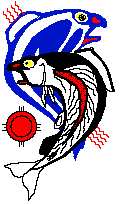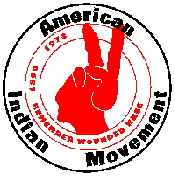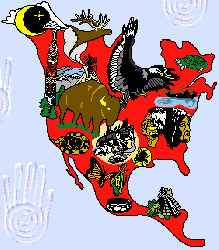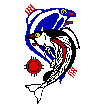



Page Navigation Buttons--- |
|---|
 This page will require a lot of help from people who have collected event and occasion buttons and posters about Indian matters over the last 30 years or so -- I think perhaps the first poster of recent Indian history may be "Alcatraz is not an Island" from the 1969 2-year occupation of Alcatraz island in San Francisco Bay by Indians of All Tribes. I'd like to try to tell the story of the relatively recent re-awakening of of Indian pride, the revival of National Sovereignty as a reality, and of the many political events, arrests, and such that occurred during this period of transition.
This page will require a lot of help from people who have collected event and occasion buttons and posters about Indian matters over the last 30 years or so -- I think perhaps the first poster of recent Indian history may be "Alcatraz is not an Island" from the 1969 2-year occupation of Alcatraz island in San Francisco Bay by Indians of All Tribes. I'd like to try to tell the story of the relatively recent re-awakening of of Indian pride, the revival of National Sovereignty as a reality, and of the many political events, arrests, and such that occurred during this period of transition.

If you have posters or buttons, you can help. Posters will have to be photographed before being scanned -- if you send me quality photos (I can't use slides) I'll try to prepare them for this page -- but I'll need your info about the events, too, and at a minimum the approximate date of the poster. The artist, if you know it, and what the event was about, as best you remember it. I know there's someone in San Francisco who has a big collection of Indian posters of the '70's, which I once saw a magazine article about; I wish this person would get in touch with me.
For buttons, the best way to handle them is to take your collection to a Kinko's copying service in your area that has a color scanner. Lay the buttons on the scanner's glass flatbed, and create a color TIFF file by scanning. Send me this file, along with the same type of info about the buttons as for the posters: approximate date, artist (if known) and what you remember about the event.
I have no camera and am not a photographer, so I'll try to get help from someone locally to photograph the several event posters I have, and will have to also use Kinko's scanner, since my scanner is just a little hand scanner that can't handle buttons (and isn't much good for anything, actually).
Another kind of help: If you see buttons and posters here and can add any more info to the description of the historical events, via your memories of them, or documents you might still have, send me this info.

The AIM patch used as a logo here has a mysterious history. Some time in late 1973 or early 1974, as the Wounded Knee, 1973, leadership trials were about to begin in St. Paul federal court, a few silk screened posters of the "hand-head, peace-and-victory" red symbol, with the lettering, "Wounded Knee -- 1890 - 1973" were left at the AIM office that was then in a condemned old church building on Aurora in St. Paul. They were very handsome and rapidly disappeared, although I saw one on the wall for a short time. I asked around and tried to find out who'd done it, and all of the obvious artists and support groups with access to silk-screens denied it was them. So I never found out who the artist was. I think the design is symbolically brilliant, combining the hand that does physical work, representing action, and the head that thinks, dreams, envisions.
Dennis Banks had one of the posters in the small back room where he slept throughout much of the early part of the year-and-a-half trial, and had 2 sizes of embroidered jacket patches made, that had the black lettering, AMERICAN INDIAN MOVEMENT around the outside, and the red lettering in a circle inside that. These jacket patches were given to AIM members who attended the "Maple Plain Regional AIM convention" that was held at Maple Plain, WI, in April of 1974. I received 2 patches -- a big one (which I gave to Nellie Red Owl), and a small one, I used as a model for the first beadwork I ever did
The AIM badge has been redesigned several times since. There is now a modern one where the profile of the face is more prominent, and yellow is used instead of white. Later, I'll scan the button or T-shirt that has this newer design.

"Putting the Indian Sign on the Americas" was an Akwesasne Notes Native Bicentennial poster by Jim Berenholz which first ran as a centerspread in Notes for the, summer, 1976, issue. Berenholz's poster was black-and-white only. It was very popular. The North American continent part was made into a T-shirt (printed on red) that Notes sold. According to several of the old Notes staff, Berenholz was a Mohawk who had joined an early revival of Mohawk culture youth group started by Ray Fadden (Tehanetorens) for Mohawk youth in the early 1950's. He had there earned the title "Keeper of the Woods", some traditional function adapted for the youth group. He left the reservation while still fairly young, and became a successful commercial artist. After Wounded Knee, when Notes took on the role of a communications center for native people everywhere, he donated several of his drawings including this poster.
In 1976, I used the north American part of the design by cut-and-paste on a poster for Paul Skyhorse and Richard Mohawk, who had been framed for a murder committed by government informants at the so-called "AIM Camp 13" in Ventura County. In 1993 I traced the entire design in FreeHand (which took 3 weeks), colored it, and made it into a poster to advertise and celebrate AIM's 25th reunion Labor Day at Ft. Snelling near St. Paul. The design was especially appropriate because this reunion was preceded by an International Indigenous People's Summit conference held in the park there, co-sponsored by AIM and the International Treaty Conference, with forums and discussion groups dealing with problems of many native peoples of Mexico, meso- and South America, and Canada.
 We Remember Wounded Knee poster -- which compares the 1890 massacre of Big Foot's band to the 1973 AIM occupation of the town, where 2 Indian people were killed by beseiging government forces -- was done for Akwesasne Notes in late 1973, in plain black on white. The artist is Bruce Grant, who donated several effective poster designs and other illustrations to Notes. The design is dramatically effective, and suggests other occasions and other where Indian women and children were menaced or massacred by troops. This design was made into a postage stamp and a T-shirt by Notes, as well as a large black-on-white poster. It was one of the most popular Notes posters of the '70's.
We Remember Wounded Knee poster -- which compares the 1890 massacre of Big Foot's band to the 1973 AIM occupation of the town, where 2 Indian people were killed by beseiging government forces -- was done for Akwesasne Notes in late 1973, in plain black on white. The artist is Bruce Grant, who donated several effective poster designs and other illustrations to Notes. The design is dramatically effective, and suggests other occasions and other where Indian women and children were menaced or massacred by troops. This design was made into a postage stamp and a T-shirt by Notes, as well as a large black-on-white poster. It was one of the most popular Notes posters of the '70's.

Custom Search
|

TOP of THIS page

BACK to ART MENU Contents Page
 CREDITS: : The logo of these art pages is "Two Fish" by Manitoulin Island Ojibwe-Odawa Martin Panamick, as explained in the Art Contents Menu page credits.
CREDITS: : The logo of these art pages is "Two Fish" by Manitoulin Island Ojibwe-Odawa Martin Panamick, as explained in the Art Contents Menu page credits.
Explanatory text and graphics copyright 1995.
Last Updated: Tuesday, December 19, 1995 - 4:57:33 AM